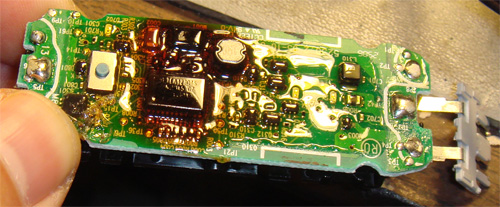dieselkraft.net has a nice photo series illustrating how Ole added an 800×600 display to a chumby by fabbing an adapter PCB and dropping the whole assembly into a beautiful antique pictureframe. Now that’s seriously cool…and I love the dieselkraft domain name!
Neat Hack
April 7th, 2009Name that Ware March 2009
April 6th, 2009The Ware for March 2009 is shown below. Click the photo for a much larger version.
This ware is interesting because it’s the guts of an appliance that I owned that nearly caught fire. The dark brown tint of the epoxy overcoat is evidence of its smokey demise. Bonus points for anyone who can correctly guess what instigated the death of this ware.
Winner of Name that Ware February 2009
April 6th, 2009The Ware for February 2009 is a P202 wifi telephony handset made for the company “Talk4free”, which actually I don’t know much about, except that it’s out of business, and that there’s a pile of these sitting in a factory in China. I was personally a bit surprised to see the all-Agere chipset — Agere is not really a leader in the wifi space. Plus, it’s using some fairly exotic memory chips (K1S3216B, a 32Mbit pseudo-SRAM). It reminds me a bit of another product I took apart once but didn’t feature on the blog (maybe I should?…hmm, I was going to draw some comparisons but now that I think about it I should save this one for later, because I’m not finding many google hits on it). Most of the part number markings and the PCB date code indicate the device was built in late 2005, so this design had been kicking around for a while. Too bad the corpse of this product can’t reveal any deeper secrets about what went wrong at the company that invested in its design; it’s always sad to see aborted products, as there’s nothing more frustrating for me than to pour my effort into a product that never sees the light of day.
Picking a winner is hard, since a lot of people guessed the type of ware correctly. I’ll more or less arbitrarily pick Brendan as the winner, since he guessed with the most detailed answer first and also took a stab at the business model behind the phone. Congrats, email me for your prize!
Chumbys available for sale to the UK
April 6th, 2009Finally, you can order a chumby from the chumby on-line store and have it shipped to the UK. Chumby has been on a long road getting past all the regulatory and trade hurdles for these shipments (and I hear there is still some obscene import tariff applied to the device by the UK), but chumby is finally shipping to its first country in the European region (we already sell in Japan and Australia).
It’s amazing how complex and difficult trade regulations can be to navigate, and the kinds of barriers that can be erected to keep you out of markets (for example, we are currently blocked from shipping to Canada over a trademark dispute). Still, it’s all a good learning experience.
Blog Upgraded
April 6th, 2009Well, I’ve upgraded to the latest WordPress, cleaned up some spam and gave the database a once-over. Hopefully the annoying spam comments are gone for everybody.
Looks like everything made it through the upgrade okay, but if you see something amiss (in particular with how comments are processed) please let me know. Sorry about the disruption, and thanks to everyone who called the problem to my attention. Since I don’t check my blog with an RSS reader I probably would never have seen those hidden links…

